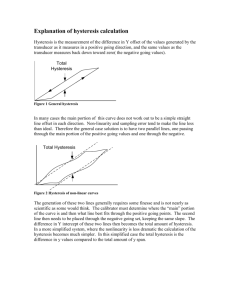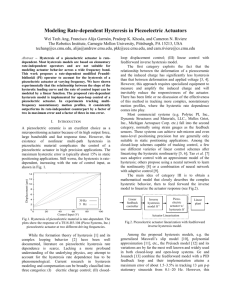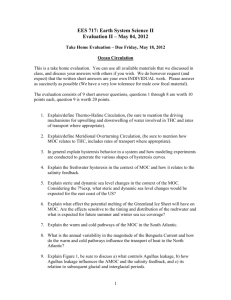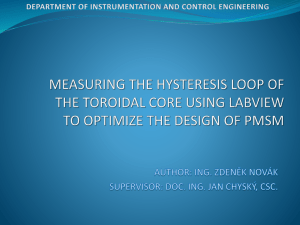hysteresis-Alija
advertisement
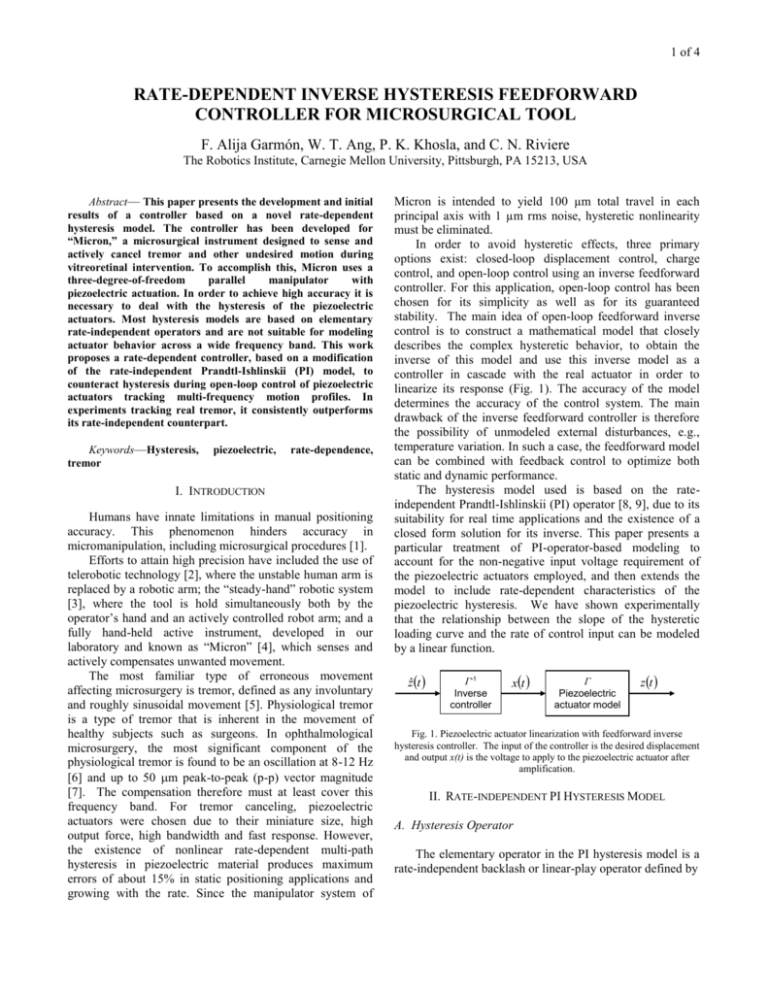
1 of 4
RATE-DEPENDENT INVERSE HYSTERESIS FEEDFORWARD
CONTROLLER FOR MICROSURGICAL TOOL
F. Alija Garmón, W. T. Ang, P. K. Khosla, and C. N. Riviere
The Robotics Institute, Carnegie Mellon University, Pittsburgh, PA 15213, USA
Abstract— This paper presents the development and initial
results of a controller based on a novel rate-dependent
hysteresis model. The controller has been developed for
“Micron,” a microsurgical instrument designed to sense and
actively cancel tremor and other undesired motion during
vitreoretinal intervention. To accomplish this, Micron uses a
three-degree-of-freedom
parallel
manipulator
with
piezoelectric actuation. In order to achieve high accuracy it is
necessary to deal with the hysteresis of the piezoelectric
actuators. Most hysteresis models are based on elementary
rate-independent operators and are not suitable for modeling
actuator behavior across a wide frequency band. This work
proposes a rate-dependent controller, based on a modification
of the rate-independent Prandtl-Ishlinskii (PI) model, to
counteract hysteresis during open-loop control of piezoelectric
actuators tracking multi-frequency motion profiles. In
experiments tracking real tremor, it consistently outperforms
its rate-independent counterpart.
Keywords—Hysteresis,
tremor
piezoelectric,
rate-dependence,
I. INTRODUCTION
Humans have innate limitations in manual positioning
accuracy. This phenomenon hinders accuracy in
micromanipulation, including microsurgical procedures [1].
Efforts to attain high precision have included the use of
telerobotic technology [2], where the unstable human arm is
replaced by a robotic arm; the “steady-hand” robotic system
[3], where the tool is hold simultaneously both by the
operator’s hand and an actively controlled robot arm; and a
fully hand-held active instrument, developed in our
laboratory and known as “Micron” [4], which senses and
actively compensates unwanted movement.
The most familiar type of erroneous movement
affecting microsurgery is tremor, defined as any involuntary
and roughly sinusoidal movement [5]. Physiological tremor
is a type of tremor that is inherent in the movement of
healthy subjects such as surgeons. In ophthalmological
microsurgery, the most significant component of the
physiological tremor is found to be an oscillation at 8-12 Hz
[6] and up to 50 m peak-to-peak (p-p) vector magnitude
[7]. The compensation therefore must at least cover this
frequency band. For tremor canceling, piezoelectric
actuators were chosen due to their miniature size, high
output force, high bandwidth and fast response. However,
the existence of nonlinear rate-dependent multi-path
hysteresis in piezoelectric material produces maximum
errors of about 15% in static positioning applications and
growing with the rate. Since the manipulator system of
Micron is intended to yield 100 µm total travel in each
principal axis with 1 µm rms noise, hysteretic nonlinearity
must be eliminated.
In order to avoid hysteretic effects, three primary
options exist: closed-loop displacement control, charge
control, and open-loop control using an inverse feedforward
controller. For this application, open-loop control has been
chosen for its simplicity as well as for its guaranteed
stability. The main idea of open-loop feedforward inverse
control is to construct a mathematical model that closely
describes the complex hysteretic behavior, to obtain the
inverse of this model and use this inverse model as a
controller in cascade with the real actuator in order to
linearize its response (Fig. 1). The accuracy of the model
determines the accuracy of the control system. The main
drawback of the inverse feedforward controller is therefore
the possibility of unmodeled external disturbances, e.g.,
temperature variation. In such a case, the feedforward model
can be combined with feedback control to optimize both
static and dynamic performance.
The hysteresis model used is based on the rateindependent Prandtl-Ishlinskii (PI) operator [8, 9], due to its
suitability for real time applications and the existence of a
closed form solution for its inverse. This paper presents a
particular treatment of PI-operator-based modeling to
account for the non-negative input voltage requirement of
the piezoelectric actuators employed, and then extends the
model to include rate-dependent characteristics of the
piezoelectric hysteresis. We have shown experimentally
that the relationship between the slope of the hysteretic
loading curve and the rate of control input can be modeled
by a linear function.
ẑ t
Γ-1
Inverse
controller
xt
Γ
Piezoelectric
actuator model
z t
Fig. 1. Piezoelectric actuator linearization with feedforward inverse
hysteresis controller. The input of the controller is the desired displacement
and output x(t) is the voltage to apply to the piezoelectric actuator after
amplification.
II. RATE-INDEPENDENT PI HYSTERESIS MODEL
A. Hysteresis Operator
The elementary operator in the PI hysteresis model is a
rate-independent backlash or linear-play operator defined by
2 of 4
y(t ) H r [ x, y0 ](t ) max x(t ) r , min{ x(t ) r , y(t T )}
y
(1)
where x is the input, y is the output, r is the input threshold
value or the magnitude of the backlash, and T is the
sampling period. Multiplying the backlash operator Hr by a
weight value wh, the generalized backlash operator is
(2)
y(t) = whHr[x, y0](t).
The weight wh defines the gain of the backlash operator
(wh = 1 represents a 45 slope) and may be viewed as the
gear ratio in a mechanical gear play analogy (see Fig. 2).
Complex hysteretic nonlinearity can be modeled by a
linearly weighted superposition of many backlash operators
with different threshold and weight values,
(3)
y(t) = whTHr[x, y0](t)
T
with the weight vector wh = [wh0 … whn], the operators
Hr[x, y0](t) = [Hr0[x, y00](t) … Hrn[x, y0n](t)]T, the threshold
vector r = [r0 … rn]T (where 0 = r0 < … < rn), and the initial
state vector y0 = [y00 … y0n]T. The threshold parameters, r,
are distributed from 0 to midrange according to
i
ri j 0 j , i 0 ... n.
(4)
Using this arrangement, the growing distance between
consecutive r’s results in a larger concentration of backlash
operators at the turning points of the control input signal.
This increases the accuracy of the model, since the turning
points are the most important part of the modeling. The
distribution only to midrange is due to the one-sided
characteristic of the piezoelectric actuators.
B. Saturation Operator
A PI operator formed with backlash operators alone
cannot model two common hysteretic phenomena:
asymmetrical shape and saturation at high input levels. To
overcome this restrictive property, a saturation operator is
combined in series with the hysteresis operator. A saturation
operator is a weighted linear superposition of one-sided
dead-zone operators. A dead zone is a nonlinear operator
given by:
max{ y (t ) d ,0}, d 0
S d [ y ](t )
d 0
y (t ),
(5)
z(t) = wsTSd[y](t)
(6)
where y is the output of the hysteresis operator, z is the
actuator response, wsT = [ws0 … wsm] is the weight vector,
and Sd[x](t) = [Sd0[x](t) … Sdm[x](t)]T with the threshold
vector d = [d0 … dm]T (where 0 = d0 < rn < d1 < … < dm).
The reason to distribute d1 to dm over the midrange point is
that saturation affects only high values of the control input.
Placing the hysteresis and saturation operators yields the
rate-independent PI operator
(7)
z(t) = [x](t) = wsTSd[whTHr[x, y0]](t).
-r
z d =0
wh
r ≥0
ws
x
d >0
y
Fig. 2. The rate-independent generalized backlash operator (at left) is
characterized by the threshold, r, and the weight, wh. The one-sided deadzone operator (at right) is characterized by the threshold, d, and the gain ws.
C. Rate-Independent Inverse PI Model
The inverse represents the reflection of the hysteretic
loop about the 45 line. The proof of existence of an inverse
can be found in [10]. The inverse PI operator is given by
(8)
1[z](t) = w’hTHr’[w’sTSd’[z], y0’](t)
and can be calculated analytically using the parameter
transformation laws presented in [10]. Cascading the
inverse hysteresis model with the actual hysteresis model, as
in Fig. 1, leads of course to the identity operator between the
control input zˆ (t ) and actuator response z (t ) :
z(t ) Γ[ Γ 1[ zˆ]](t ) I [ zˆ](t ) zˆ(t ) .
(9)
D. Parameter Identification
To find the hysteresis model parameters, the responses
of the actuator first have to be measured. Then, the threshold
values r and d are set as described in the previous section,
and finally weight parameters wh and ws are found by
performing a least squares minimization of the error
E[ x, z]w s , wh , t w sT Sd [whT H r [ x, y0 ]](t ) z(t ). (10)
III. RATE-DEPENDENT PI HYSTERESIS MODEL
An extension to the rate-independent PI model is
proposed in this section to also model the rate-dependent
characteristics of the piezoelectric hysteresis.
1) Rate-dependent Model Identification: The response of a
piezoelectric actuator is measured tracking constant-rate
sawtooth control inputs at different rate values over the
range of 01000 m/s. This corresponds to the maximum
rate of sinusoidal control input up to 25 Hz with 12.5 m pp amplitude. PI parameter identification is performed for the
measured actuator response at different rate values. The
sums of the hysteresis operator weights, defined as
Whi
i
j 0
whj , i 0... n ,
are plotted against control input rate in Fig. 3.
(11)
3 of 4
1.2
Wh 9
Sum of weights
0.8
Wh 2
0.4
Wh1
0
Wh 0
-0.4
0
200
400
600
Control Input Rate (m/s)
800
1000
Fig.3. Plot of the sum of the hysteresis operator weights vs. input rate.
Linear dependence can be observed.
The sum of the weights is used instead of one or more
individual weight values because the linear fit is more
accurate. A standard deviation of 0.04 is the result for Wh0,
making it the roughest linear fit among all Whi.
Thus the rate-dependent hysteresis slope model is:
Whi ( x (t )) Ai x (t ) Bi , i 0... n
(12)
where Ai is the slope of the best fit line and Bi is the
hysteresis slope at zero input rate. The individual ratedependent weight values can be calculated by
whi ( x (t )) ai x (t ) bi , i 0... n
(13)
measured response of the piezoelectric actuator subjected to
a 10 Hz, 12.5 m p-p sinusoidal control input.
Fig. 4 compares the experimental results of the rateindependent and rate-dependent PI operators tracking real
tremor. Recordings of the hand motion of ophthalmologic
surgeons [11] were made available by Prof. R. S. Rader of
The Johns Hopkins University. Each surgeon held a
microsurgical instrument with the tip inserted in a
sclerotomy in the eye of a mannequin face. A Hall effect
sensor mounted inside the mannequin eye detected the
position, in one dimension, of a 0.26 g permanent magnet
mounted on the tip in the instrument. Data were recorded for
16 seconds and at 1 kHz sampling frequency. The tremor
was then estimated using a bandpass filter. The corner
frequencies were set at 6 and 16 Hz to provide flat response
in the 8-12 Hz band. Table I summarizes the performance
of the rate-independent and rate-dependent controllers
during the experiment.
TABLE I
MEASURED EXPERIMENTAL ERRORS DURING TRACKING OF REAL
TREMOR
Results Comparison
Raw hysteresis Rate-Independent
Rmse (m)
Rmse / p-p
ampl.(%)
max error
(m)
max error / pp ampl.(%)
Rate-Dependent
0.86
0.29
0.08
6.21
2.32
0.64
1.82
0.66
0.32
14.5
5.3
2.4
where
a0 A0 ; ai Ai A(i 1) , i 1... n;
(14)
V. DISCUSSION
b0 B0 ; bi Bi B(i 1) , i 1... n.
(15)
In order to suppress erroneous motion, the actuators of
Micron must move the tool tip in opposition to the tremor;
i.e., they should track a tremulous motion. Due to the
modulating or nonstationary nature of the tremor, rate
effects must be taken into account. The rate-independent
controller, though it reduces significantly the hysteretic
effects of the piezoelectric actuators, is outperformed by the
rate-dependent controller. The rate-dependent open-loop
controller permits attainment of the goal of 0.125 µm rms
error per actuator, as specified in the design of Micron.
One limitation of all PI-type hysteresis models is
singularity when the slope of the hysteresis loading curve
becomes zero. The inverse model near the singularity is
highly sensitive to noise, wherefore the range of dependence
must be bounded to avoid control errors. The singularity of
the proposed rate-dependent model occurs at around 700
m/s, which is equivalent to the maximum rate of a 20 Hz,
12.5 m p-p sinusoid. However, Micron actuators track
motions only up to approximately 12 Hz, therefore they
work in the safe range. If desired, wider spacing of weights
could be used for higher bandwidth.
2) Rate-dependent PI Hysteresis Model: With the ratedependent extension, the PI hysteresis model is defined by
T
(16)
z(t ) Γ[ x, x](t ) ws Sd [wh ( x(t ))T H r [ x, y0 ]](t ).
The inverse rate-dependent modified PI operator is as
follows:
Γ 1[ zˆ]t wh, ( x(t ))T H , ( x(t ))[w s,T S , [ zˆ], y 0, ](t ).
r
d
(17)
The rate-dependent transformation laws for w’h( x (t)) can be
found in the same way as the rate-independent, by replacing
wh with the rate-dependent wh( x (t)).
IV. RESULTS
To model the hysteretic nonlinearity of a TS18-H5-104
piezoelectric stack actuator (Piezo Systems, Inc.,
Cambridge, Mass.), we used a PI model of n = 9 and m = 2,
for both the rate-independent and rate-dependent cases. The
rate-independent model parameters were identified from the
4 of 4
Measured
Desired
VI. CONCLUSION
14
A novel rate-dependent controller based on the PrandtlIshlinskii (PI) rate-independent hysteresis model has been
presented, to account for the behavior of a piezoelectric
actuator in an active tremor-canceling microsurgical
instrument. The proposed system uses a linear function to
model the relationship between the parameters of the
hysteresis operators and the rate of control input. This
controller yields better experimental results than the rateindependent controller.
Displacement (m)
12
10
8
6
4
2
0
Error
0
REFERENCES
0.2
Time (s)
0.4
0.6
(a)
14
Displacement (m)
12
10
8
6
4
2
0 Error
0
0.2
Time (s)
0.4
0.6
0.4
0.6
(b)
14
Displacement (m)
12
10
8
6
4
2
Error
0
0
0.2
Time (s)
(c)
Fig.9. Experimental open-loop tracking results for real tremor. The
rate-independent model parameters are identified from the
measured response of the piezoelectric actuator subjected to a 10
Hz, 12.5 m p-p sinusoidal input. (a) Without model. (b) Rateindependent hysteresis model. (c) Rate-dependent model.
[1] R. C. Harwell and R. L. Ferguson, “Physiologic tremor and
microsurgery,” Microsurgery, vol. 4, pp. 187-192, 1983.
[2] I. W. Hunter, T. D. Doukoglou, S. R. Lafontaine, P. G. Charette,
L. A. Jones, M. A. Sagar, G. D. Mallinson, and P. J. Hunter, “A
teleoperated microsurgical robot and associated virtual
environment for eye surgery,” Presence, 2:265-280, 1993.
[3] R. Taylor, P. Jensen, L. Whitcomb, A. Barnes, R. Kumar, D.
Stoianovici, P Gupta, Z. Wang, E. de Juan, and L. Kavoussi, “A
steady-hand robotic system for microsurgical augmentation,” in:
C. Taylor, A. Colchester (eds.) Medical Image Computing and
Computer-Assisted Intervention – MICCAI’99. Springer, Berlin,
pp. 1031-1041.
[4] W. T. Ang, C. N. Riviere, and P. K. Khosla, “Design and
implementation of active error canceling in a hand-held
microsurgical instrument,” Proc. IEEE/RSJ Int. Conf. Intell.
Robots and Systems, Hawaii, Oct. 29-Nov. 3, 2001.
[5] R. J. Elble and W.C. Koller, Tremor. Baltimore: Johns Hopkins,
1990.
[6] C. N. Riviere, R. S. Rader, and P. K. Khosla, “Characteristics of
hand motion of eye surgeons,” Proc. 19th Int. Conf. IEEE Eng.
Med. Biol. Soc., Chicago, 1997.
[7] S. P. N. Singh, C. N. Riviere, “Physiological tremor amplitude
during retinal microsurgery,” Proc. 28th IEEE Northeast Bioeng.
Conf., Phila. Pa., 2002, pp. 171-172.
[8] P. Krejci and K. Kuhnen, “Inverse control of systems with
hysteresis and creep”, IEE Proc. Control Theory Appl., vol. 148,
no.3, May 2001.
[9] K. Kuhnen and H. Janocha, “Complex hysteresis modeling of a
broad class of hysteretic nonlinearities”, Proc. 8th Int. Conf. on
New Actuators, Bremen, pp. 688-691, Jun. 2002.
[10] K. Kuhnen, H. Janocha, “Inverse feedforward control for the
large signal operation of piezoelectric actuators”(in German), atAutomatisierungstechnik, vol. 50, 9/2002, S. 439-450.
[11] C. N. Riviere and P. K. Khosla, “ Augmenting the humanmachine interface: Improving manual accuracy,” Proc. IEEE Int.
Conf. Robot. Autom., Albuquerque, N.M. Apr. 20-25, 1997.
